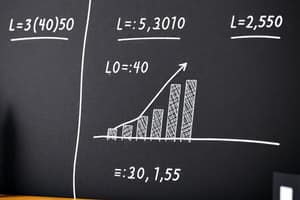Podcast
Questions and Answers
What is the purpose of empirical Bayes in statistics?
What is the purpose of empirical Bayes in statistics?
- To design experiments for optimal inferences
- To prove the Neyman-Pearson Theorem
- To estimate unknown parameters using observed data (correct)
- To calculate the Cramer-Rao Inequality
Which theorem deals with the optimality of unbiased estimation?
Which theorem deals with the optimality of unbiased estimation?
- Lehmann-Scheffé Theorem
- Rao-Blackwell Theorem (correct)
- Neyman-Pearson Theorem
- Cramer-Rao Inequality
What is the purpose of likelihood ratio tests in hypothesis testing?
What is the purpose of likelihood ratio tests in hypothesis testing?
- To compare two nested models (correct)
- To establish the power function of a test
- To calculate Type I and Type II errors
- To define rejection regions and test functions
In the context of model checking, what does the Chi-Squared Goodness of Fit Test assess?
In the context of model checking, what does the Chi-Squared Goodness of Fit Test assess?
What is the Bayesian formulation primarily used for in statistics?
What is the Bayesian formulation primarily used for in statistics?
What is the focus of experimental design in statistics?
What is the focus of experimental design in statistics?
What topic does section 10.3.4 focus on?
What topic does section 10.3.4 focus on?
In section 10.4.3, what type of analysis is discussed for two categorical predictors?
In section 10.4.3, what type of analysis is discussed for two categorical predictors?
What mathematical concept is associated with the Markov Chain Limit Theorem?
What mathematical concept is associated with the Markov Chain Limit Theorem?
Which section explores the topic of Brownian Motion?
Which section explores the topic of Brownian Motion?
Which section introduces the concept of Martingales?
Which section introduces the concept of Martingales?
What is the focus of section 10.5?
What is the focus of section 10.5?
What is the main focus of Chapter 10 in the text?
What is the main focus of Chapter 10 in the text?
What type of topics are covered in Chapter 11 according to the text?
What type of topics are covered in Chapter 11 according to the text?
Which chapters are essential for understanding the topics covered in Chapter 11?
Which chapters are essential for understanding the topics covered in Chapter 11?
What kind of course would cover chapters 5–7 and 9–10 according to the text?
What kind of course would cover chapters 5–7 and 9–10 according to the text?
Which topics would a one-semester course on probability cover?
Which topics would a one-semester course on probability cover?
What is the relevance of model checking in statistical practice based on the text?
What is the relevance of model checking in statistical practice based on the text?
Flashcards are hidden until you start studying
Study Notes
Purpose of Empirical Bayes
- Empirical Bayes provides a practical approach for estimating posterior distributions by using observed data to inform prior distributions, often improving estimation accuracy in small-sample scenarios.
Theorem on Optimality of Unbiased Estimation
- The Rao-Blackwell theorem addresses the optimality of unbiased estimation, which states that any unbiased estimator can be improved by conditioning on a sufficient statistic, leading to a lower variance.
Likelihood Ratio Tests in Hypothesis Testing
- Likelihood ratio tests evaluate the fit of two hypotheses by comparing the maximum likelihoods under each hypothesis; they help determine if the additional complexity of a model is justified.
Chi-Squared Goodness of Fit Test
- The Chi-Squared Goodness of Fit Test assesses how well observed data align with expected frequencies under a specific theoretical distribution, allowing insights into model adequacy.
Bayesian Formulation in Statistics
- The Bayesian formulation primarily facilitates statistical inference by incorporating prior beliefs with new data through Bayes' theorem, allowing for updated probability assessments.
Focus of Experimental Design
- Experimental design in statistics emphasizes structuring experiments to ensure valid results, focusing on randomization, replication, and blocking to eliminate bias and variability.
Section 10.3.4 Focus
- Section 10.3.4 concentrates on the analysis of variance (ANOVA), discussing methods for comparing means across multiple groups and understanding variation sources.
Analysis for Two Categorical Predictors in Section 10.4.3
- Section 10.4.3 discusses logistic regression analysis tailored for two categorical predictors, analyzing their simultaneous effects on a binary response variable.
Mathematical Concept of Markov Chain Limit Theorem
- The Markov Chain Limit Theorem pertains to the convergence of Markov chains, detailing conditions under which they reach a steady-state distribution regardless of initial conditions.
Section on Brownian Motion
- The topic of Brownian Motion is explored in section 10.5, which examines its properties, mathematical representations, and applications in various statistical contexts.
Introduction of Martingales
- The concept of Martingales is introduced in section 10.4, outlining this fundamental process in probability theory where future expected values remain consistent based on past information.
Focus of Section 10.5
- Section 10.5 focuses on advanced stochastic processes, particularly emphasizing properties and applications of Brownian motion and martingales in statistical models.
Main Focus of Chapter 10
- Chapter 10 primarily addresses stochastic processes, detailing various types, their mathematical frameworks, and relevance in statistical modeling and hypothesis testing.
Topics Covered in Chapter 11
- Chapter 11 covers advanced statistical methods, including multivariate analysis and inferential techniques designed for complex data structures and relationships.
Essential Chapters for Chapter 11 Understanding
- Chapters 5, 7, and 9 are essential for understanding Chapter 11's concepts, as they provide foundational knowledge in probability theory and initial statistical methods.
Course Types Covering Chapters 5–7 and 9–10
- A graduate-level statistics course would typically cover chapters 5–7 and 9–10, focusing on both theoretical and applied statistical methodologies.
Probability Topics in a One-Semester Course
- A one-semester course on probability would include basic probability theory, random variables, probability distributions, and introductory statistics.
Relevance of Model Checking in Statistical Practice
- Model checking is crucial in statistical practice as it ensures model adequacy and validity, providing confidence that conclusions drawn are based on properly specified models.
Studying That Suits You
Use AI to generate personalized quizzes and flashcards to suit your learning preferences.



